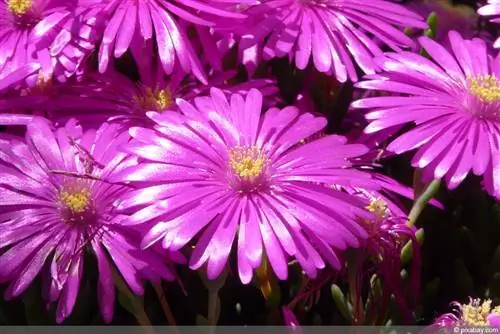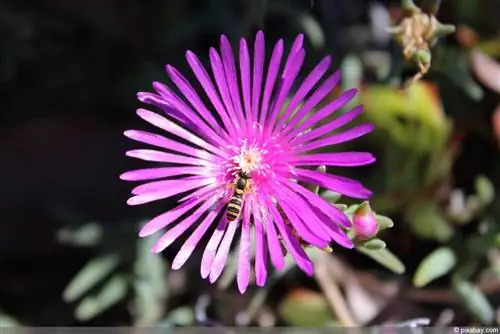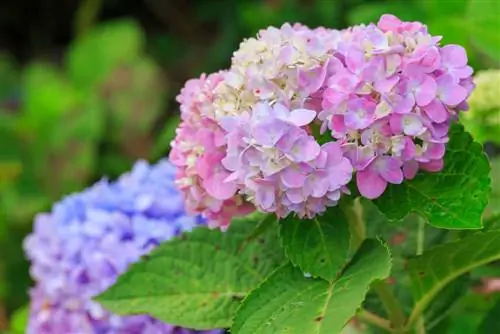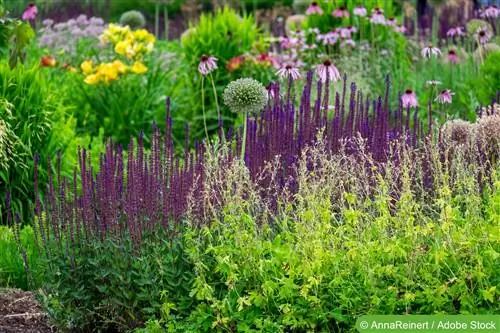- Author admin [email protected].
- Public 2023-12-17 03:39.
- Last modified 2025-01-24 12:45.
A wide variety of plants are called ice plants because they open their flowers when there is sufficient brightness and sunlight. The Mesembryanthemum species are succulent plants that thrive in sandy and dry locations. Some species grow in coastal regions and store s alt in their leaves. This makes these edible plants popular vegetables. Caring for the pale pink, yellow or white-flowering plants is not difficult.
Location
Midday flowers prefer a bright place. In their natural distribution area, the herbaceous plants grow in full sun locations. They are therefore suitable for decorating south-facing window sills. During the summer months, Mesembryanthemum species enjoy a place on the sunny balcony or the light-flooded terrace. The ornamental perennials need a protected place outdoors, as falling rainwater can destroy the delicate petals.
As winter approaches, the potted plants are moved to their winter quarters. An unheated and bright room or a winter garden is ideal. Ice plants spend the frosty months at temperatures between eight and ten degrees Celsius.
Tip:
Not all of these succulents are perennials. Most ornamental plants such as iceweed are cultivated as annuals and cannot be overwintered.
Substrate and soil
Species of the genus Mesembryanthemum grow in light soils with high permeability. Waterlogging causes the fine roots to rot. As a result, the plants cannot absorb water or nutrients, causing the leaves to slowly die. In its natural habitat, the ice plant thrives on sandy soils. Organic components ensure that nutrient requirements are adequately covered. The ideal substrate mix consists of sand or gravel and potting soil. Alternatively, you can use commercially available soil for cacti and succulents. These substrate mixtures are perfectly adapted to the needs of water-storing plants and provide optimal growth conditions. Ice plants prefer dry soil conditions and thrive in periods of low rainfall. This way of life is possible thanks to a special adaptation that makes the succulent plants particularly resilient.
- large, leathery leaves serve to store water
- The plants survive drought without any problems
- Leaves become tender and soft under sunny and dry conditions
- Shade and moisture make the leaves crisp and firm
Plants
From mid-May, the young plants are planted in the desired location in the garden. It is enough to plant one plant per square meter. If a dense population is desired, two copies are sufficient. The ice plant plants develop abundant branches, the shoots of which lie low and in this way develop mat-like carpets. A plant can crawl between 70 and 100 centimeters above the ground.
- ideal as a ground cover
- looks great as a solitary perennial
pot planting
Species of the genus Mesembryanthemum develop a compact root system with fibrous fine roots that do not grow very deep into the soil. Despite the nutrient-poor conditions in the sandy soil, the plants do not have to develop an extensive root system because they store not only water but also nutrients and s alts in their leathery leaf tissue. This compact network of roots makes the ice plant the perfect plant for containers. Choose an appropriately large pot as the plants develop enormous biomass and can easily fall over. A heavy vessel shifts the center of gravity to the ground.
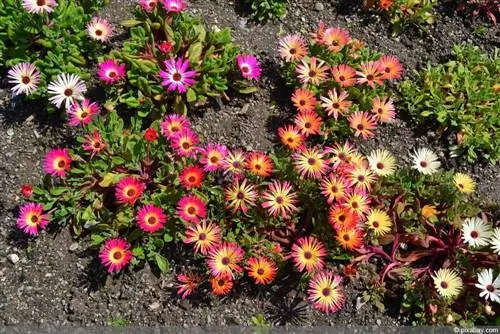
The creeping shoots create a slightly drooping growth habit. The succulents look good in hanging pots and are suitable for planting under large perennials in taller pots. The pots decorate roof terraces or balcony gardens. They decorate the foreground of heat-storing walls or south-facing house walls.
Tip:
Use terracotta or clay pots. The coarse-pored material regulates the moisture content in the substrate and prevents waterlogging.
Pouring
Care for ice plants is reduced to a minimum. As succulent plants, they don't immediately drop their leaves if you forget to water them. Thanks to their water-storing tissue, the plants can survive long periods of drought. Even before the water storage has been used up, Mesembryanthemum species need water replenishment. Water the plants thoroughly with low-lime rainwater or stale tap water.
Make sure there is good water drainage. If your ice plant grows in a pot, no water should collect in the saucer. The fine roots react sensitively when surrounded by standing water. In winter, the ice plants need less water. Between March and October you can reduce the watering units.
Tip:
When the leaves become soft and pliable, it is high time for a watering session.
Fertilize
Cat flowers are happy about an additional supply of nutrients. The first fertilization begins shortly before the start of the new growing season in spring. From this point on, the plant is regularly supplied with nutrients. If you use liquid fertilizer, you should reduce the recommended amount by half. This will prevent over-fertilization. If you want to harvest the leaves, you should use a fertilizer recommended for vegetables. Well-ripened compost, which is mixed into the substrate in spring, is ideal. Compost also acts as a long-term fertilizer and supplies the plant with valuable nutrients throughout the summer.
- fertilize every two weeks in summer
- alternatively provide compost before budding
- stop fertilization in winter
Cutting
Pruning is necessary in spring if the plant received too little light in winter. Lack of light leads to the formation of long shoots on which the leaves are widely spaced. The plant looks unsightly. Cut back disturbing shoots. Ice plants tolerate vigorous pruning and then sprout again lushly. After the flowering period, wilted flowers should be removed regularly. This measure stimulates the plant to form new buds.
Tip:
During the growing season, you can pinch off leafy shoot tips every three to four weeks. New branches emerge below the break points.
Wintering
Mesembryanthemum species come from warm regions where winters are mild or temperatures hardly fluctuate throughout the year. If temperatures are low around freezing point in the natural distribution areas, the plants grow predominantly as annuals. Perennial plants are overwintered in a cool and bright place where the thermometer falls just below zero degrees. In winter the plants require a minimal amount of care:
- Provide plants with sparse water every month
- do not fertilize
Propagate
The succulent plants, like all thick-leaved plants, can be propagated in two ways. Propagation from cuttings is suitable for regular rejuvenation, while young plants grown from seeds bring new genetic material into the stock.
Seeds
The ice plants can be propagated like other succulents using seeds that are scattered on a nutrient-poor growing substrate in spring. Press the seeds lightly and moisten the substrate using a spray bottle. The fine mist of water prevents the seeds from being washed away and covered with soil. Under constant humidity and temperatures between 20 and 22 degrees Celsius, the seeds germinate within the next two weeks. During this time, the cultivation container should be placed in a bright location. The seedlings are separated when they have grown a few centimeters high and are easy to touch.
Tip:
You can easily mix your own growing substrate. Use one part sand and one part coconut fiber for this.
Cuttings
In late summer you can cut shoots from a strong mother plant and propagate them as cuttings. If you cut the plant back in spring, you will have good material for propagation from cuttings. So that the interface can dry, you should store the shoot in the air for a short time.
The cuttings are then planted in a mixture of sand and soil. They need a bright location where there is no direct sunlight. If you grow autumn cuttings, you should place the planter in a cool winter quarter with temperatures between eight and ten degrees Celsius. Keep the substrate evenly moist for the first few weeks. A fine atomizer is suitable for this so that the soil does not get wet. Autumn cuttings require more time to root than fresh shoots cut in spring.
- Shoots should be between ten and 15 centimeters long
- Cuttings need at least two to three leaves
- Leaves that are too large will be shortened
Diseases and pests
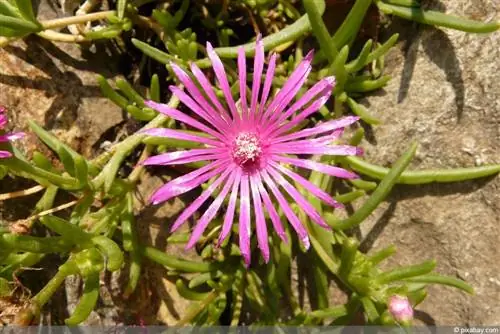
A spray solution of water and milk in a ratio of one to eight helps against powdery mildew infestation, which spreads preferentially in dry and warm weather. In spring, ice plants are occasionally attacked by aphids. Suboptimal care promotes the spread of pests. The tiny insects prefer to attack weak and ailing plants. Nitrogen-based fertilization promotes infestation. In the initial stages it is sufficient to wipe off the unwanted residents with a cloth. Alternatively, you can spray the pests with a sharp jet of water. If the infestation is more advanced, a neem preparation can help. Additionally, spray the affected leaves with a home-made nettle decoction and regularly strengthen weakened plants with plant extracts. These not only prevent aphids but also other typical pests such as:
- Thrips
- Spider mites
- Mealybugs and scale insects
Popular species and planting partners
Species of the genus Mesembryanthemum are rarely found commercially. One of the better known species is Mesembryanthemum crystallinum. Iceweed grows as an annual, but can be cultivated as a biennial with overwintering. It develops small leaves with a firm tissue structure, the surface of which is covered with shiny silvery glands. This phenomenon earned the herb the nickname ice pearl salad. The decorative shape harmonizes with other succulent plants:
- White Stonecrop (Sedum album)
- Fat leaf rosette (Echeveria elegans)
- Club rush cactus (Hatiora salicornioides)
It may be that when you buy an ice herb you are holding a different species in your hands. The heart-leaved ice plant is occasionally offered under the same name or with the scientific name Mesembryanthemum cordifolia. According to recent findings, this ice plant belongs to the genus Aptenia, which means that the species is only distantly related to the actual ice plant. This plant grows as an annual and develops significantly larger leaves and more leaf mass than iceweed.

